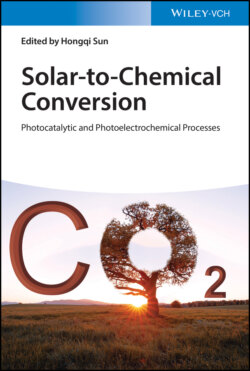Читать книгу Solar-to-Chemical Conversion - Группа авторов - Страница 21
2.4.1.4 Formic Acid (HCOOH)
ОглавлениеFormic acid, the two‐electron reduction product of CO2, has recently attracted attention as a storage source of H2. Formic acid itself is an important chemical. It has been employed as a preservative and an insecticide and is also a useful acid, reducing agent, and source of carbon in synthetic chemical industries. Analyzing the reduction reaction of CO2 to HCOOH, as shown in Eqs. (2.8, 2.10), it is found that this reaction involves multiple steps and multiple electrons so that the efficiency and yield are relatively low and the by‐products undermine the selectivity of HCOOH through a series of competitive reactions. Therefore, unique photocatalysts or photoelectrocatalysts should be developed to meet the need of CO2 conversion to HCOOH:
(2.8)
(2.9)
(2.10)
Recently, bimetallic‐graphene (Pt@Au@rGO) system has been reported by Kim and coworkers, in which the hybridized system is composed of gold nanoparticles (30 nm) as the core and ultrasmall platinum nanoparticles as the satellites wrapped by RGO [49]. The results demonstrate that the noble metal nanoparticles can efficiently improve the selectivity for HCOOH formation because noble metal can decrease the overpotential of hydrogen production from water splitting, therefore beneficial to the hydrogenation of CO2, in particular Pt nanoparticles compared with other noble metals. On the other hand, it is reported that CB of g‐C3N4 has enough high position, located at −1.23 V, which is more negative than the reduction potential of CO2/CH3OH (−0.38 V) and CO2/HCOOH (−0.61 V). Therefore, it is often viewed as an effective photocatalyst for CO2 photoreduction to methanol and formic acid. For example, Adekoya et al. constructed g‐C3N4/(Cu/TiO2) nanocomposites through coupling g‐C3N4 with Cu‐modified TiO2 to suppress the rapid recombination of photoinduced charge carriers in pristine g‐C3N4 [50]. As a result, the nanocomposite photocatalyst displayed enhanced photoreduction abilities of CO2 to CH3OH and HCOOH under UV and visible‐light irradiation. Meanwhile, the yield of HCOOH (5069 μmol gcat−1) is much higher than that of CH3OH (2574 μmol gcat−1), but the selectivity is not good. According to the analysis of HCOOH formation and related literatures, it seems that higher CB potential and lower overpotential hydrogen facilitate the yield of HCOOH, while it is observed that the by‐product CH3OH is higher, which is a strong competitive reaction due to the lower redox potential compared with that of HCOOH synthetic reaction [51]. Consequently, only introducing new component for enhanced charge separation and solar harvesting is hardly to achieve high selectivity of HCOOH. Therefore, novel photocatalysts with new reaction path of HCOOH should be considered and developed.
In 1992, Matsuoka et al. reported a oligo(p‐phenylenes) organic molecular photocatalyst for CO2 photoreduction to formic acid with small quantity of CO in a nonaqueous solvent under UV light illumination [52]. To further improve the selectivity of formic acid and efficiency, Tamaki and coworkers designed a series of Ru(II) supermolecular photocatalysts that exhibit high electivity and turnover frequency (TOF) under visible‐light irradiation [53]. By means of combining photosensitizer units and catalyst units, a trinuclear complex displayed 0.061 of formic acid yield, 671 of TON, and 11.6 min−1 of TOF. Recently, Tamaki et al. prepared a novel sacrificial electron donor, 1,3‐dimethyl‐2‐(o‐hydroxyphenyl)‐2,3‐dihydro‐1H‐benzoimidazole, for efficient supermolecular photocatalyst, further increasing reduction efficiency of CO2 to HCOOH, where the TONHCOOH and TOFHCOOH reached to 2766 and 44.9 min−1, respectively, under visible‐light irradiation [54].
Owing to the high cost and unrecyclable properties of homogeneous photocatalysts, chemical scientists pay more attention to combine solid semiconductor photocatalysts with liquid organic supermolecular photocatalysts together to overcome these obstacles as well as maintain high efficiency and selectivity. For instance, Suzuki et al. reported that a hybrid photocatalyst that consisted of Ru(II) complex and N‐doped Ta2O5 anchored with an organic group was fabricated through a direct assembly route [55]. In Figure 2.11a, when the N‐Ta2O5 was excited by suitable light source, the photogenerated electrons at the CB of N‐Ta2O5 transferred to the Ru complex, in which the two‐electron reduction of CO2 to HCOOH can be easily triggered. Nevertheless, the solid semiconductor and organics should be assembled by a certain organic ligand to realize electron transfer process. To reach the goal, phosphonate and carboxylic groups were introduced to link the inorganic and organic components. The inorganic/organic system modified by phosphonate or carboxylic groups exhibited excellent photoconversion activity of CO2 to formic acid under visible‐light irradiation with respect to the reaction rate and stability, as shown in Figure 2.11b. On the other hand, the rapid and efficient electron transfer can be achieved by adjusting the position of CB of semiconductor. For example, recently, Maeda and coworkers developed a Ru(II) complex/C3N4 hybrid photocatalyst for improving the photocatalytic reduction efficiency of CO2 to HCOOH (selectivity >98%) under longer wavelength visible (λ > 500 nm) through a copolymerization preparation method, as shown in Figure 2.11c–d [56]. For the copolymerized C3N4 nanosheets fabricated by combing urea with phenylurea in high temperature, the absorption edge can be extended to 650 nm, which can significantly enhance photocatalytic activity and selectivity of modified Ru(II) complex/C3N4 system to HCOOH under longer‐wavelength light source irradiation.
Figure 2.11 (a) Mechanism for the reduction of CO2 by photocatalysis under visible light with a Ru complex and an N‐Ta2O5 hybrid catalyst. (b) Turnover number for HCOOH formation from CO2 over various molecular systems as a function of irradiation time. (c) Schematic mechanism of visible‐light‐driven photocatalytic CO2 reduction over RuP/NS‐C3N4 hybrids. (d) Time courses of photocatalytic CO2 reduction using RuP/NS‐C3N4‐PU0 and RuP/NS‐C3N4‐PU90 under visible light (λ > 400 nm).
Source: (a) Suzuki et al. [55]; (b) Sato et al. [55]; (c) Tsounis et al. [56]; (d) Tsounis et al. [56].
